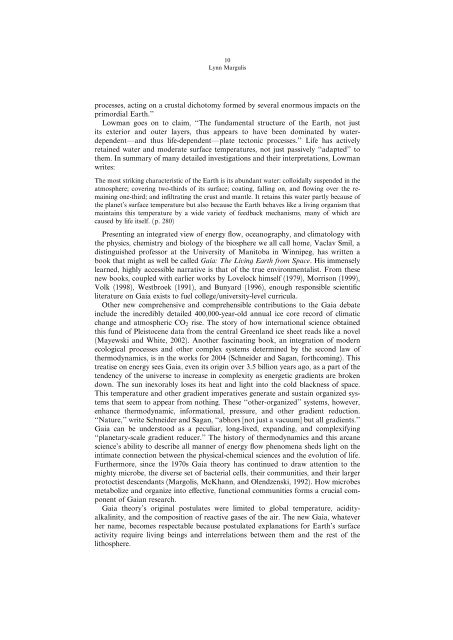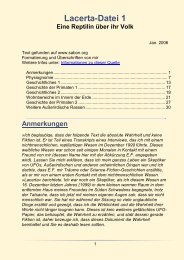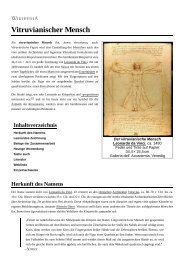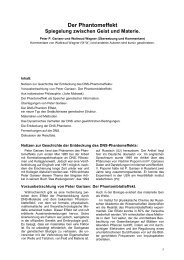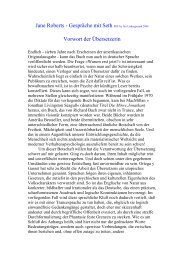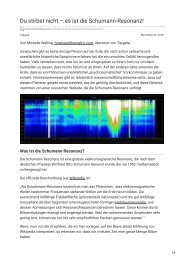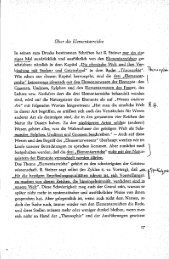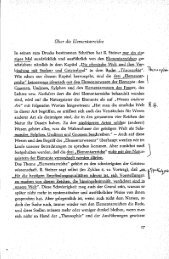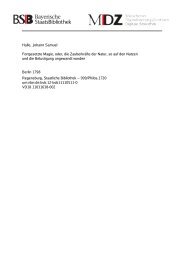Die Gaia-Hypothese
Erfolgreiche ePaper selbst erstellen
Machen Sie aus Ihren PDF Publikationen ein blätterbares Flipbook mit unserer einzigartigen Google optimierten e-Paper Software.
10<br />
Lynn Margulis<br />
processes, acting on a crustal dichotomy formed by several enormous impacts on the<br />
primordial Earth.’’<br />
Lowman goes on to claim, ‘‘The fundamental structure of the Earth, not just<br />
its exterior and outer layers, thus appears to have been dominated by waterdependent—and<br />
thus life-dependent—plate tectonic processes.’’ Life has actively<br />
retained water and moderate surface temperatures, not just passively ‘‘adapted’’ to<br />
them. In summary of many detailed investigations and their interpretations, Lowman<br />
writes:<br />
The most striking characteristic of the Earth is its abundant water: colloidally suspended in the<br />
atmosphere; covering two-thirds of its surface; coating, falling on, and flowing over the remaining<br />
one-third; and infiltrating the crust and mantle. It retains this water partly because of<br />
the planet’s surface temperature but also because the Earth behaves like a living organism that<br />
maintains this temperature by a wide variety of feedback mechanisms, many of which are<br />
caused by life itself. (p. 280)<br />
Presenting an integrated view of energy flow, oceanography, and climatology with<br />
the physics, chemistry and biology of the biosphere we all call home, Vaclav Smil, a<br />
distinguished professor at the University of Manitoba in Winnipeg, has written a<br />
book that might as well be called <strong>Gaia</strong>: The Living Earth from Space. His immensely<br />
learned, highly accessible narrative is that of the true environmentalist. From these<br />
new books, coupled with earlier works by Lovelock himself (1979), Morrison (1999),<br />
Volk (1998), Westbroek (1991), and Bunyard (1996), enough responsible scientific<br />
literature on <strong>Gaia</strong> exists to fuel college/university-level curricula.<br />
Other new comprehensive and comprehensible contributions to the <strong>Gaia</strong> debate<br />
include the incredibly detailed 400,000-year-old annual ice core record of climatic<br />
change and atmospheric CO 2 rise. The story of how international science obtained<br />
this fund of Pleistocene data from the central Greenland ice sheet reads like a novel<br />
(Mayewski and White, 2002). Another fascinating book, an integration of modern<br />
ecological processes and other complex systems determined by the second law of<br />
thermodynamics, is in the works for 2004 (Schneider and Sagan, forthcoming). This<br />
treatise on energy sees <strong>Gaia</strong>, even its origin over 3.5 billion years ago, as a part of the<br />
tendency of the universe to increase in complexity as energetic gradients are broken<br />
down. The sun inexorably loses its heat and light into the cold blackness of space.<br />
This temperature and other gradient imperatives generate and sustain organized systems<br />
that seem to appear from nothing. These ‘‘other-organized’’ systems, however,<br />
enhance thermodynamic, informational, pressure, and other gradient reduction.<br />
‘‘Nature,’’ write Schneider and Sagan, ‘‘abhors [not just a vacuum] but all gradients.’’<br />
<strong>Gaia</strong> can be understood as a peculiar, long-lived, expanding, and complexifying<br />
‘‘planetary-scale gradient reducer.’’ The history of thermodynamics and this arcane<br />
science’s ability to describe all manner of energy flow phenomena sheds light on the<br />
intimate connection between the physical-chemical sciences and the evolution of life.<br />
Furthermore, since the 1970s <strong>Gaia</strong> theory has continued to draw attention to the<br />
mighty microbe, the diverse set of bacterial cells, their communities, and their larger<br />
protoctist descendants (Margolis, McKhann, and Olendzenski, 1992). How microbes<br />
metabolize and organize into e¤ective, functional communities forms a crucial component<br />
of <strong>Gaia</strong>n research.<br />
<strong>Gaia</strong> theory’s original postulates were limited to global temperature, acidityalkalinity,<br />
and the composition of reactive gases of the air. The new <strong>Gaia</strong>, whatever<br />
her name, becomes respectable because postulated explanations for Earth’s surface<br />
activity require living beings and interrelations between them and the rest of the<br />
lithosphere.


